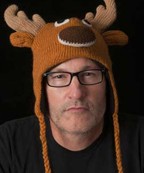Loren answers common questions:
How long does it take to make the pictures for a book?
It can be a long process — it usually takes months of work, and hundreds of hours planning, sketching and painting. As a result, I'm only able to make one or two books a year.
What were some of your favorite books as a child?
Where do you get your ideas?
Do you prefer writing or illustrating?
I’ve written a story for a children’s book, do you have any tips on how to get it published?
Everyone who plans to work in the children's book industry should get a copy of Children's Writer's and Illustrator's Market by Chuck Sambuchino. This will tell you about all of the different publishers, what kind of books they publish, what kinds of books they are looking for, details on how to submit a book to them, and their contact information. Many famous books were rejected first by several publishers, so be persistent and keep trying if the first publisher you find is not interested.
Also, join the SCBWI — Society of Children's Book Writers and Illustrators (http://www.scbwi.org/). The organization provides many resources for writers and artists working in (or hoping to work in) the children's book industry. They also host local workshops and conferences — you can find a wealth of educational material on how to prepare your artwork or manuscript and how to submit it, and can ask questions and join in online discussions.
If you are a writer, submit your story alone to publishers without artwork. Editors like to read and judge a story on its own merit. And if they wish to publish it, they want to be able to find the perfect illustrator out there that they feel will help your story come to life. Actually, the wrong illustrations for your story could hurt its chances of getting a serious look from an editor. This is just my two cents worth. But if you have a dream to work in the children’s literature field, consider the tips above, plug in and find your own answers. Every published author and illustrator I know in the field has taken a different path to get where they are.
Do your best to plug in to the children's literature world. Join a writer's or illustrator's critique group. Talk to children's librarians about their favorite books, new and old. Talk to the manager or buyer of the children's department in a bookstore. Follow your favorite writers and illustrators on social media. Listen to children's book podcasts like The Yarn, The Growing Readers Podcast, The Children's Book Podcast, and The Illustration Department Podcast, to name a few.
Also, click here to read a helpful step by step piece on how to write a picture book by Mac Barnett and editor, Taylor Norman.
I’ve written a story for a picture book; if I send it to you would you consider illustrating it?
I’ve written a story for a children’s book; may I send it to you for some feedback?
Will you sign books for me?
Yes, I’m happy to sign as many books as you want to send. Please include return postage and a note with names if you want them personalized or indicate if you just want an autograph. It is a good idea to remove the dust jacket so that it does not get damaged. Send your book(s) to this address:
Loren Long
P.O. Box 43038
Cincinnati, Ohio 45243
Perhaps the best way to get signed copies of any of my books is to order them from my friends at The Bookshelf in Cincinnati. They are in my neighborhood and will take your order, have me sign and personalize the books and ship them directly to you. This is a convenient way to get signed and personalized copies of my books and support an independent bookstore.
email: cincybookshelf@gmail.com
phone: (513)271-9140
Do you have a pet?
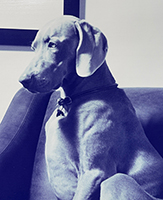
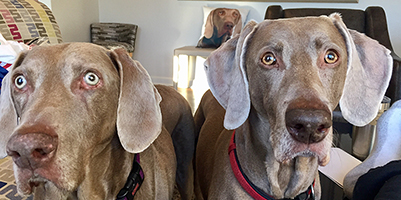
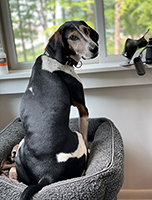
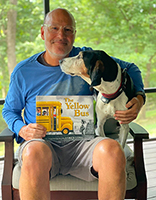
Yes, I’m a dog lover and friend to all animals. My wife, Tracy, and I have raised two human boys and four dogs. Our first dog was our beloved Stella. After Stella, we adopted Ellewoods (Ellie) and got a beautiful little puppy, we named Moon. They were all three Weimaraners. Sadly, they are no longer with us but they were dearly loved and will remain in our hearts forever.
During the pandemic in 2020 we adopted Charlie. He’s a hound dog who stole our hearts immediately. He’s the very best boy and spends his days with me as a studio companion. If I’m in my studio working on a book, he is in there with me. He’s my best buddy.
What is your favorite color?
I heard you are colorblind. How can you be an artist?
Yes, I am a colorblind artist. It is referred to as red-green colorblindness and is fairly common in males. The degree of colorblindness varies from person to person. I can't see the difference in green, brown and grey. And blue and purple look exactly the same to me. All the different shades of greyed down colors can be tricky as well. I have learned the basics of color theory and the Primary, Secondary and Tertiary colors on the color wheel. Understanding how color works, can be very helpful, even if you can't completely see all of its range.
I've always felt that even though I can't discern certain hues against one another, my sense of value is heightened. Value is about shades of darks and lights, and everything in between. As opposed to hue, which is the color of an object. For example, I can see that something is light green as opposed to dark green. It's just that I may think it's dark grey, or dark brown. Same with blues and purples.Ultimately this has been, and can be still to this day, an annoying obstacle in my work as an artist, but not a barrier.
There are ways to work around it. When laying out my palette to start a painting, I place colors the same way on my palette every time with the purple and lavenders on the opposite side from the blues. I place the browns far away from the greens. And then I take a marker and write the colors next to the blobs of paint.
Early on I had to accept that I had limitations as an artist. I could never be a classic portrait painter or paint the figure like a John Singer Sargent. Skin tones are far too subtle and varied and nuanced for me to be able to see the range of hue in a face with other nearby colors and light affecting the flesh tone. When painting the figure, I do my best to add color around highlights and paint with reflective light and color in the shadows. But regardless of what I might be painting, I still mostly focus on simplifying and leaning into the value of the subject. Seeing and composing the darks and lights of an object is the key for me.
I have difficulty matching most colors. This can be a problem from time to time, if I'm on my own.
This brings me to the most important part. My entire life as an artist I have asked for help.
Once I was tested and diagnosed as color blind as a kid, my mother helped me out. In the beginning of my career I worked as an illustrator at a greeting card company and coworkers would help me when I had to match colors. And now my wife, Tracy, helps when I am having trouble with colors or matching something. In fact, I haven't let one piece of art from any of my books leave my studio unless Tracy has looked them carefully over. She's my ultimate color vision.
I've learned that there are lots of colorblind artists out there in the world. It's a little annoying, even frustrating at times. But manageable.
If you're interested in reading more, here's a New York Times article about this subject and me.
